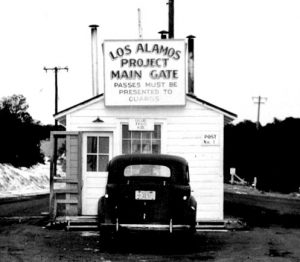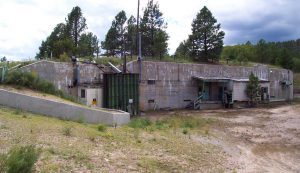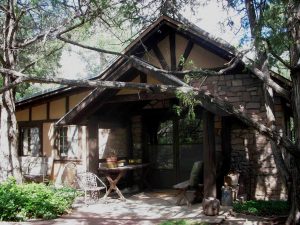
Los Alamos, home of the weapons laboratory directed by J. Robert Oppenheimer, is the site the public most associates with the Manhattan Project.
For over a decade, the Atomic Heritage Foundation has worked in collaboration with the Los Alamos Historical Society, the Bradbury Science Museum, and the Los Alamos National Laboratory to preserve, restore, and interpret Los Alamos’ historic Manhattan Project properties.
Click here for a walking tour of historic Los Alamos.
After the Manhattan Project
The original technical buildings around Ashley Pond were torn down more than forty years ago. By 1997, only fifty Manhattan Project properties scattered in remote parts of the laboratory were left. Most were built to last the duration of the war and had been abandoned in mid-1950s. By the mid-1990s, nature had begun its own process of demolition. While the laboratory was required to mitigate the loss of historic properties, preservation was not considered an option. Isolated in space and time, few people even knew these buildings existed. The historic buildings today range from technical laboratories, such as the Gun Site and the V Site, to the homes of scientists on the famed Bathtub Row, including the Oppenheimer and Bethe Houses. Both the Gun Site and the V Site connect us to the “galaxy of luminaries” recruited by J. Robert Oppenheimer to build the world’s first atomic bombs.
In 2013, CBS aired a segment aired an excellent segment on the proposed Manhattan Project National Historical Park during its show, CBS This Morning. Lee Cowan, a CBS National Correspondent, traveled to Los Alamos, NM to view the sites. Ellen McGehee, Los Alamos National Laboratory Historic Buildings Manager, led CBS crews to the Gun Site, the V Site, and the Quonset Hut, where assembly work on the “Fat Man” bomb was done before it was shipped to Tinian. Cowan also interviewed Helene Suydam, 92, the current owner of the house where J. Robert Oppenheimer and his family lived during the Manhattan Project.
The V Site

A cluster of humble wooden buildings called “V Site” are surrounded by ponderosa pines as occasional herds of mule deer trot across the surrounding meadows. The central building has high-bay doors that once swung open for the “Gadget,” the world’s first atomic device tested on July 16, 1945. The V Site housed the design efforts of the plutonium implosion device commonly known as the “Gadget.”
In its report to New Mexico’s environmental authorities on the V Site buildings in the 1990s, the laboratory condemned the buildings, citing contamination with asbestos shingles and possible residues of high explosive materials. Fortunately, the Advisory Council on Historic Preservation (ACHP), a small Federal agency, agreed to take an independent look at the V Site properties.
The Council members were struck by the contrast between the simplicity of structures and the complexity of what took place inside them. Subsequently, Los Alamos National Laboratory (LANL) management agreed to remove all of the V Site buildings from the demolition list. After the Department of Energy applied for one of the first “Save America’s Treasures” grants for Federal properties in danger of being lost, the National Park Service awarded the V site a $700,000 matching grant for restoration and preservation efforts.
Inspired by the restoration of the V Site, in 2000 the Department of Energy listed eight properties as Signature Facilities of the Manhattan Project. The list included the V Site and Gun Site at Los Alamos, the X-10 Graphite Reactor, Beta-3 Calutrons and K-25 Gaseous Diffusion Plant at Oak Ridge, and the B Reactor and T Plant at Hanford.
Today, the V Site remains ready to be incorporated into a Manhattan Project National Historical Park pending approval from Congress and transmittal of recommendations for the park from the Department of Interior.
The Gun Site

The Atomic Heritage Foundation has worked with the Los Alamos National Laboratory and private donors to preserve the Gun Site, a historic building where the “Little Boy” bomb was assembled. The Gun Site is located just off West Jemez Road in Los Alamos. Once part of Anchor Ranch, during the Manhattan Project the site was called Technical Area 8. Here Manhattan Project scientists and engineers developed and tested the gun-type weapon that works by firing a large cylinder of fissile material into a smaller quantity of the same material. When the two come together, they form a critical mass and set off a chain reaction that produces a nuclear explosion. The scientists fired material using a Naval cannon and observed the results through a periscope from the safety of a concrete bunker. These experiments were critical to the design of the “Little Boy” or uranium-based bomb dropped on Hiroshima.
The Gun Site was named as one of three Signature Facilities of the Manhattan Project at Los Alamos, along with the “V Site” (TA-16-516) and the “Fat Man” assembly and Loading Quonset hut (TA-22-1). AHF has found a donor willing to fund a significant portion to completely restore the property, but must wait until the park has been established and donations can be accepted.
The Oppenheimer House

From 1943-1945, J. Robert Oppenheimer lived with his wife Kitty and children Peter and Toni in a house on Bathtub Row. Oppie and Kitty hosted martini-fueled parties at the house. Many scientists played musical instruments, including physicist Edward Teller, who enjoyed playing the piano. If the Oppenheimer parties grew too large, people spilled out on the lawn. Oppenheimer often asked the military police to declare the entire area “secure” so the guests could freely discuss their top-secret work on the bomb.
Helene Suydam, 93, is the current owner of the Oppenheimer House. She and her late husband Bergen (Jerry) Suydam, a theoretical physicist, came to LANL in 1947 and purchased the house in 1956. Helene is always willing to share charming stories about the house and what it was like when the Oppenheimers lived there.
In 2003, the Los Alamos Historical Society entered a living trust agreement with the Suydams. The agreement transfers title to the historical society but permits the Suydams to live there as long as they wish. Later, the Suydams generously decided not to ask for compensation but to donate the property to LAHS.
The modest house covers about 1,200 square feet and appears much as it did when Oppenheimer family lived there. As Helene explained, “We did not change a thing.”
Photographs of Oppenheimer entertaining guests in the living room eerily evoke a sense of their presence. When a Manhattan Project National Historical Park is created, it will be a “jewel in the crown” of the Manhattan Project experience in Los Alamos.
The Bethe House
In October 2013, the Los Alamos Historical Society (LAHS) announced that it had received an extremely generous gift from Clay and Dorothy Perkins: $530,000 to purchase and restore the Hans Bethe House on Bathtub Row. The Bethe House (1350 Bathtub Row) is next door to the Oppenheimer House, which was donated to the LAHS by Helene and Gerry Suydam under a living trust agreement. Nobel Laureates Hans Bethe and Edwin McMillan both lived in the house during the Manhattan Project.
LAHS will use the Bethe House to interpret the history of Los Alamos during the Cold War. The new interpretative center will be named the Harold Agnew Cold War Museum in honor of Harold Agnew, the Manhattan Project veteran and the third director of the Los Alamos National Laboratory Director (1970-1979) who passed away on September 29, 2013. Agnew and Perkins were good friends. When Perkins first told Agnew of his forthcoming donation, Agnew responded laconically. But upon seeing a photograph of the Bethe House, he exclaimed, “I stayed there a lot!” The museum will be a terrific way to honor Agnew and the people who worked at Los Alamos during the Cold War.




